JAPANESE TEXTILES TECHNIQUES
Shibori resist
With a 1500 year history in Japan, Shibori, or the inventive art of shaped resist as defined by Yoshiko Iwamoto Wada is the collective term for a multiplicity of bound, stitched, folded, clamped and pole bound methods of creating pattern on textiles.
Patterns are traditionally dyed using indigo, although the techniques were also applied to beautiful natural dyed silk fabrics as well.
Boro mending
Boro (or more accurately “Boro boro”) means “rags and tatters” in Japanese are refers to the endlessly patched and repaired clothing and bedding made by the very poorest farming people in Japan. Unable to buy new fabric, clothing or bedding, they cobbled together whatever scraps they could find and endlessly mended these fabrics.
Katagami/Katazome stencil resist
Katagami stencilling came into being as a means to create intricate, crisp patterns from finely cut handmade paper stencils. Stencil cutting is a highly skilled craft with a ten year apprenticeship. The use of stencils to dye fabric is known as Katazome and is practiced by a different group of equally talented craftspeople.
Katagami originated in Ise in Mie prefecture and thi is still the home of the papermaking and stencil cutters.
Kogin counted thread sashiko
Kogin counted thread sashiko embroidery originated in the cold, Northern part of Honshu (Japan’s main island) in Hirosaki City. It was used to decorate Sunday best jackets to go to the temple and was comprised of repeating motifs in the form of squares arranged in a diamond formation to create panels of pattern.
Sashiko embroidery
Sashiko, derived from the Japanese verb Sasu meaning “to stab'“ or “to pierce”, was a country craft used to decorate clothing and homewares
Typically stitched by poor farming women, the skill was so highly prized it affected a young girl’s chances of marriage. In Moyozashi sashiko patterns are created using even running stitch that never touches. And, in Hitomezashi sashiko patterns are created by stitching the horizontal pattern stitches and then the vertical pattern stitches to a grid and the stitches meet to form the patterns.




